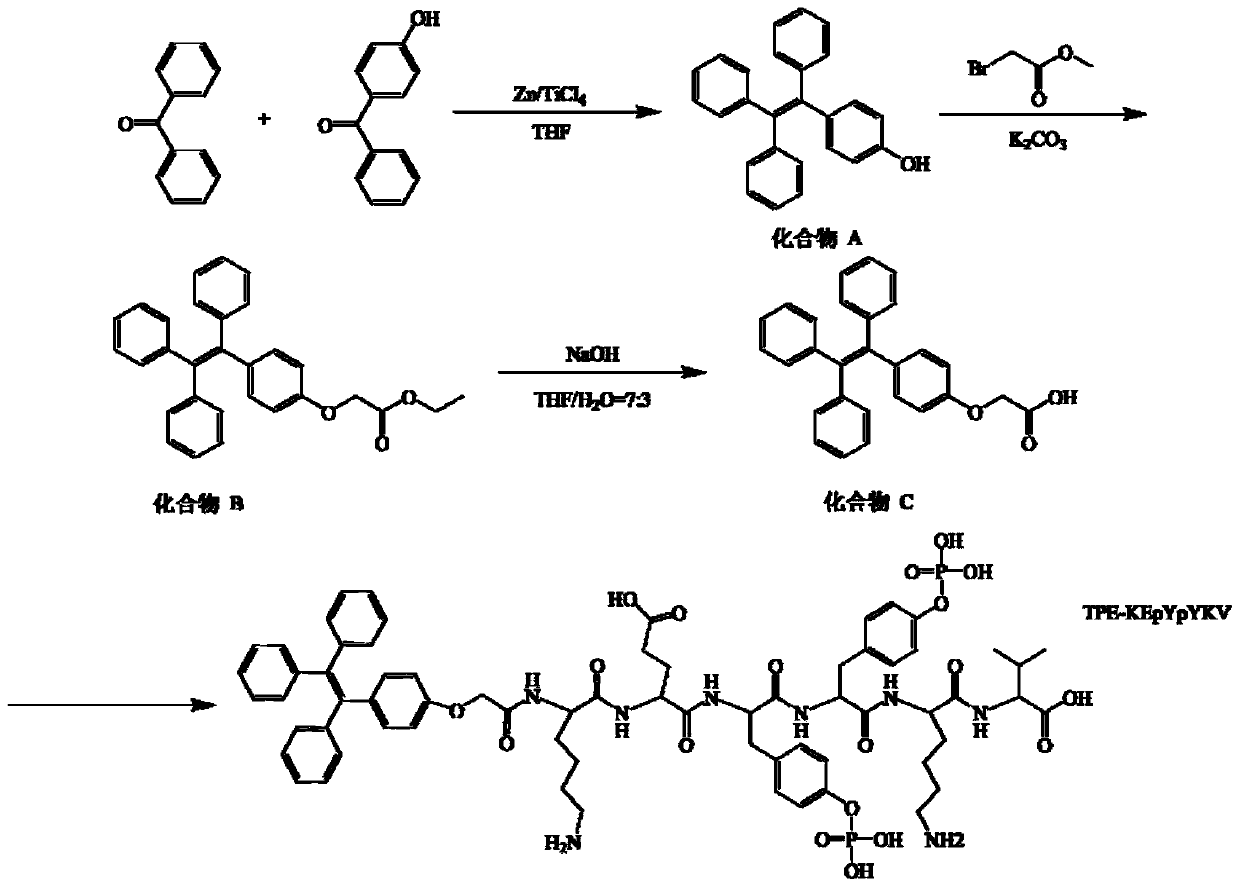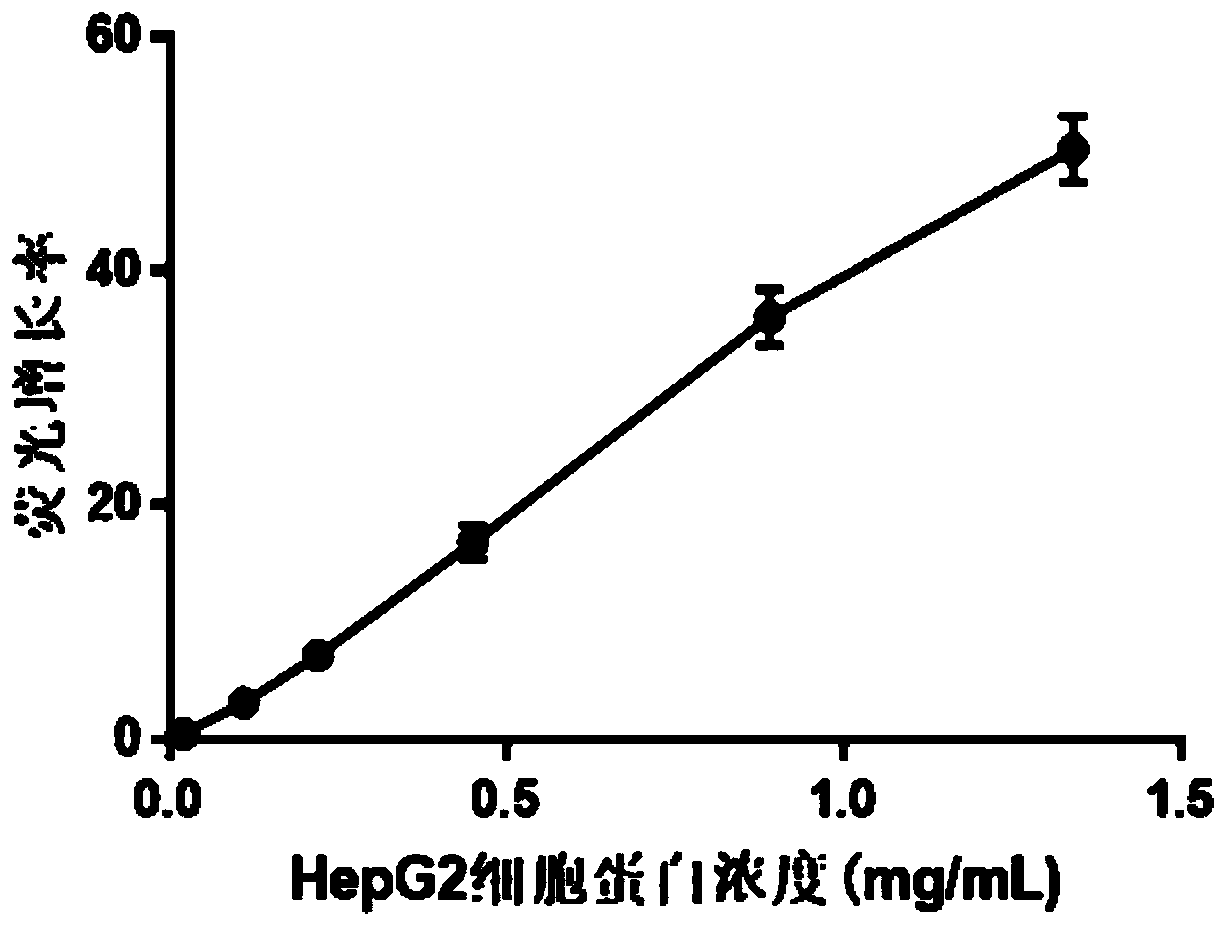Polypeptide for PTP1B detection and fluorescent probe comprising polypeptide
A fluorescent probe and solid-phase peptide synthesis technology, applied in the field of fluorescent probes, can solve the problems of inability to directly detect the activity of PTP1B, the influence of compound structure, and the high requirements of detection environment.
- Summary
- Abstract
- Description
- Claims
- Application Information
AI Technical Summary
Problems solved by technology
Method used
Image
Examples
Embodiment 1
[0045] Embodiment 1 has the fluorescent probe synthesis of AIE characteristic
[0046] This embodiment provides a method for synthesizing a fluorescent probe with AIE characteristics, and its synthesis process is as follows figure 1 shown, including:
[0047] (1) Separately synthesize a polypeptide chain through a solid-phase polypeptide synthesis reaction, and the sequence of the polypeptide chain is lysine-glutamic acid-phosphorylated tyrosine-phosphorylated tyrosine-lysine-valine;
[0048] (2) Add 4-hydroxybenzophenone (1.9g, 10mmol), benzophenone (2.2g, 12mmol) and zinc powder (2.9g, 44mmol) into a 250ml three-necked flask, pump air, nitrogen, and repeat three times; Add 80ml of THF (tetrahydrofuran), 0 ℃ ice-water bath for 30min; dropwise add titanium tetrachloride (2.4ml, 22mmol) under ice-water bath, reflux overnight, spin dry; add appropriate amount of dichloromethane and dilute hydrochloric acid for extraction, remove the organic layer, dried with anhydrous magnesiu...
Embodiment 2
[0052] Example 2 Application of Fluorescent Probe TPE-KEpYpYKV in PTP1B Activity Detection
[0053] (1) Fluorescence spectrum analysis of the fluorescent probe and the product after the reaction between the fluorescent probe and the enzyme.
[0054] Sample group 1: Add 50 μL of fluorescent probe TPE-KEpYpYKV with a concentration of 100 μM;
[0055] Sample group 2: Add 1.5 μL of PTP1B with a concentration of 40 μg / mL, 50 μL of fluorescent probe TPE-KEpYpYKV with a concentration of 100 μM;
[0056] The two sample groups were buffered with Tris-HCl (10mM, pH 7.5, containing 50mM Na + , 2mMDTT) to 100 μL, and incubated at 37°C for 15 minutes. After the reaction, a Tecan microplate reader was used to measure the fluorescence spectrum from 400 nm to 600 nm under 320 nm excitation.
[0057] See the test results figure 2 .
[0058] Depend on figure 2 It can be seen that the synthesized fluorescent probe TPE-KEpYpYKV basically has no fluorescence absorption in the range of 400-...
Embodiment 3
[0063] Example 3 Application of Fluorescent Probe TPE-KEpYpYKV in Screening PTP1B Inhibitors
[0064] (1) Application of fluorescent probe TPE-KEpYpYKV in screening PTP1B inhibitors
[0065] Take 50 μL of fluorescent probe TPE-KEpYpYKV with a concentration of 100 μM, add 1.5 μL of PTP1B with a concentration of 40 μg / mL and a certain volume of different concentrations of Na 3 VO 4 Mother liquor (making Na 3 VO 4 The final concentration is 0.5, 1, 5, 25, 125, 250, 500μM), with buffer Tris-HCl (10mM, pH 7.5, containing 50mMNa + , 2mMDTT) to 100μL, incubate at 37°C for 15min, measure with a Tecan microplate reader, set E x 320nm (±5nm), E m 480nm (±5nm).
[0066] See the test results Figure 5 .
[0067] Depend on Figure 5 It can be seen that with Na 3 VO 4 Concentration increases, Na 3 VO 4 The inhibitory effect on PTP1B also gradually increased; indicating that the fluorescence growth rate of the fluorescent probe TPE-KEpYpYKV can better reflect the inhibitory effe...
PUM
 Login to View More
Login to View More Abstract
Description
Claims
Application Information
 Login to View More
Login to View More - R&D
- Intellectual Property
- Life Sciences
- Materials
- Tech Scout
- Unparalleled Data Quality
- Higher Quality Content
- 60% Fewer Hallucinations
Browse by: Latest US Patents, China's latest patents, Technical Efficacy Thesaurus, Application Domain, Technology Topic, Popular Technical Reports.
© 2025 PatSnap. All rights reserved.Legal|Privacy policy|Modern Slavery Act Transparency Statement|Sitemap|About US| Contact US: help@patsnap.com



